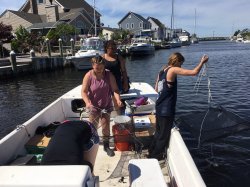A Once-in-a-Lifetime Opportunity
Researchers to “bar code” Barnegat Bay Estuary before and after power plant shutdown
Posted in: Research, Science and Technology, University

The nation’s oldest active nuclear power plant – the Oyster Creek Nuclear Generating Station (OCNGS) in Lacey, New Jersey – opened in 1969. In October 2018, it will shut down a year ahead of schedule. News of the projected closing was welcomed by a team of Montclair State researchers who believe that the plant’s cooling system – which draws in and releases several billions of gallons of bay water a day – is responsible for significant changes in the Barnegat Bay ecosystem. The shutdown presents the team with a unique opportunity to assess OCNGS’ impact on the Barnegat Bay Estuary.
Biology professors Paul Bologna, John Gaynor and Robert Meredith have received an award of $62,942 for the first year of a proposed three-year project from the New Jersey Department of Environmental Protection (NJDEP) to study the profound impact OCNGS has had on the community structure of gelatinous zooplankton – or jellyfish – in the Barnegat Bay Estuary waters drawn in and released by the plant.
“This is a truly once-in-a-lifetime opportunity for us to collect incredible data before and after the decommissioning of a nuclear power plant,” says Bologna, who is the project’s lead principal investigator, or PI. “It’s highly likely that the combined research and efforts will generate information relevant to many different power and industrial plants.”
As Co-PI Meredith sees it, the project also offers an unprecedented opportunity to conduct “a mini-experiment of global climate change and its potential impact.”
Collecting the Data
In early July, Bologna and a team of undergraduate and graduate students began collecting, processing, identifying and measuring samples in the field. Large organisms collected in the bay will be brought back to tanks in his campus lab, where students will continue to count and identify them. Ultimately, these organisms will be compared to those collected after the OCNGS shuts down.
“We have to make the most of this opportunity,” he says. “This is the only chance we get to sample the organisms in the water before the plant closes, so that we can do effective comparative studies once it is decommissioned.”
While Bologna is overseeing the collection of samples, Gaynor and Meredith are tackling the project from the molecular angle, using DNA analysis to identify any unknown organisms that have been collected. Their efforts, according to Bologna, will essentially “bar code” the bay.
“I’ll be isolating and sequencing metagenomic DNA from samples taken from both Oyster Creek and surrounding areas,” Meredith says. “The metagenomic analysis will target a specific region of DNA from all organisms in the samples, so that they can be identified.”
Understanding the Changes
The professors look forward to determining the impact of the plant on the bay by discovering – and pinpointing – differences between the types of organisms collected before and after the plant shutdown.
“I would expect the area influenced by the warm water discharge from the plant to return to what it was like prior to the plant being built,” says Meredith. “How long this will take, though, is anyone’s best guess.”
Once the OCNGS is shut down, and the amount of water that is being drawn into the plant and discharged back into the bay is drastically reduced, Bologna expects that the impact will be seen on everything from crabs and eelgrass to larval fish and jellyfish.
“We think a lot of jellyfish have been sucked up and killed, which is a good thing,” Bologna says. “Would an unintended consequence of the plant closing be an increase in the jellyfish population? Or have the jellyfish benefited from the extra warm water that is returned to the bay from the plant? We don’t know the answers to these questions yet.”
While several students are currently working on the project, Bologna projects that all told, as many as eight to 10 undergraduate and graduate students – including at least one PhD candidate – will have the opportunity to help the professors determine just how the OCNGS has impacted the Barnegat Bay Estuary ecosystem.
